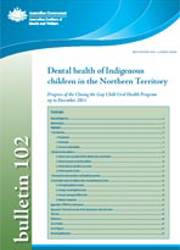Summary
This bulletin presents information on the dental health status and the dental services provided under the Closing the Gap (CtG) Child Oral Health Program to Indigenous children living in prescribed communities of the Northern Territory. While this program specifically targets Indigenous children who had dental referrals during their child health checks it also provides dental services to all Indigenous children less than 16 living in prescribed communities.
A total of 14,834 dental services were provided to 8,317 children between August 2007 and 31 December 2011. Of these children only 6,480 (78%) provided consent to share the detailed information on their oral health status and treatment with the AIHW and therefore much of the analyses in this bulletin are restricted to this group.
Highlights from the analyses include the following:
- Almost all children attending a dental service received a diagnostic service before proceeding with specific treatment. A large proportion of children also received preventative (82%) and restorative treatments (47%).
- Of the 3,223 Indigenous children who had received a dental referral during their health checks 2,458 (76%) had received a dental service, 756 (23%) had an outstanding dental referral indicating further need for services and 9 (less than 1%) children were considered loss-to-follow up. The average waiting time between referral and service was 18 months.
- The need for further services was highlighted by the fact that 2,001 children were referred for additional treatment or services for their oral health conditions identified during their dental visits.
- Of the children who received a dental service between 1 January and 30 June 2011 for whom decayed, missing or filled teeth (DMFT/dmft) was reported, 82% had a dental caries experience with an average of 4.5 caries per child.
- Compared with the national result from the 2006 Child Dental Health Survey, the proportion of children aged 5–12 experiencing dental caries among those who received dental services through the Closing the Gap Child Oral Health Program was 23 percentage points higher.
- About 56% of children who received dental services were treated for at least one oral health problem. The most commonly treated oral health problems were untreated caries (52%), mouth infections and dental abscesses (5%).
- For children who had two or more courses of dental care, the overall proportion seen with at least one oral health problem decreased by about 13 percentage points between their first and the most recent course of care. In addition, the prevalence of untreated carries and mouth infection or mouth sores were decreased by 14 and 6 percentage points respectively between the two courses of care. The minimum time interval between the first and latest course of care was 9 months and the median time interval was 21 months.
- Among children who were treated for mouth infections or mouth sores and untreated carries at their first course of dental care, 97% and 60% did not have the same problem at their most recent course of care respectively.



